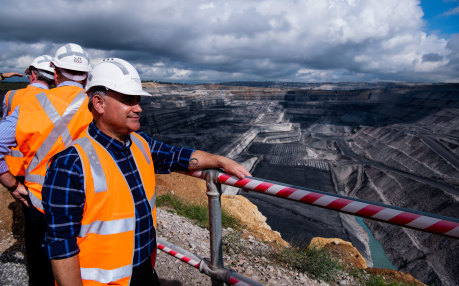Mining companies will be forced to show plans for the ongoing rehabilitation of their mines and to report on their progress as the NSW government moves to tighten rules around environmental management.
Deputy Premier and Mining Minister John Barilaro said the reforms would “ultimately ensure that mining leaseholders progressively rehabilitate mine sites over the course of their project, and not just at closure”.

Mining Minister John Barilaro at the Ravensworth coal mine, north of Singleton, during the Upper Hunter byelection.Credit: James Brickwood
“After extensive public consultation, new standard mining lease conditions for rehabilitation will now be introduced on all mining leases,” Mr Barilaro said.
“Previously, a mining operation may have been subject to several different rehabilitation and environmental management conditions, making compliance, monitoring, and regulation complex.”
The rehabilitation of mines has been a long-standing issue, with the NSW Audit Office warning in 2017 that security deposits of the state’s 450 mines “do not include sufficient contingency given the substantial risks and uncertainties associated with mine rehabilitation and closure.
During the Upper Hunter byelection in May it emerged that mining companies in the Hunter had failed to set aside enough money to fill in their voids or maintain vegetation once their mines come to the end of their lives.
Japanese trading giant Idemitsu was identified as falling short in its efforts to replant pasture and woodlands on its Muswellbrook Coal mine in the Upper Hunter, a report by the Australia Institute showed.
The report found filling in the region’s 23 mine voids would cost between $11.5 billion and $25.3 billion, based on the stated costs per hectare of four mines in the Upper Hunter.
The government holds $3.3 billion in bonds to meet the rehabilitation costs of all mines across NSW.
The state budget in June allocated more than $100 million for major remediation works to be completed over 10 years at abandoned and historic mine sites, primarily in locations where production ceased between 50 and 100 years ago – in areas including Captains Flat and sites in the Central West and Northern Tablelands
The changes will require all mining leaseholders to prepare a management plan to identify and achieve rehabilitation outcomes and carry out rehabilitation risk assessments.
They will also need to develop a program to demonstrate an approach to progressive rehabilitation, make information about rehabilitation publicly available and report annually on rehabilitation performance.
Mr Barilaro said the changes build on the government’s commitment to improve regulation in the sector and the work of the NSW Resources Regulator to promote accountability of rehabilitation requirements.
“Providing detailed public reporting and presenting case studies are measures that are helping to improve the transparency and understanding of mine rehabilitation. These changes will provide peace of mind to many.”
The Morning Edition newsletter is our guide to the day’s most important and interesting stories, analysis and insights. Sign up here.